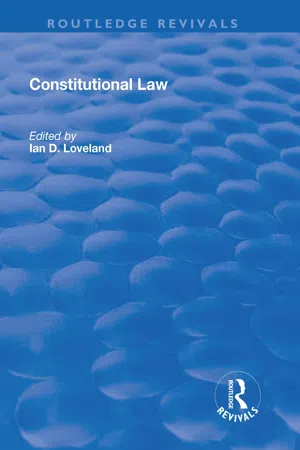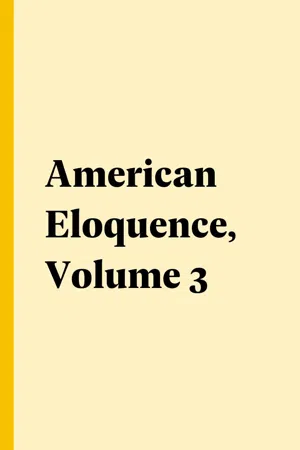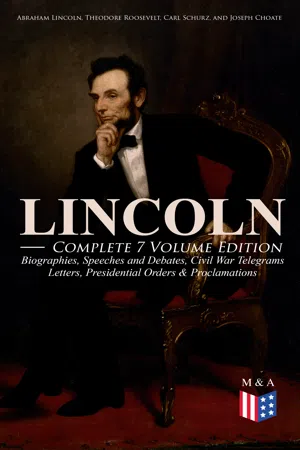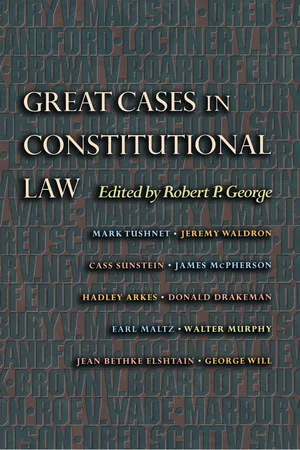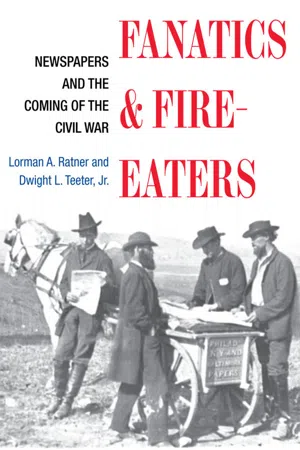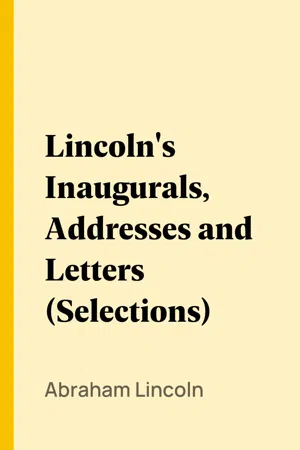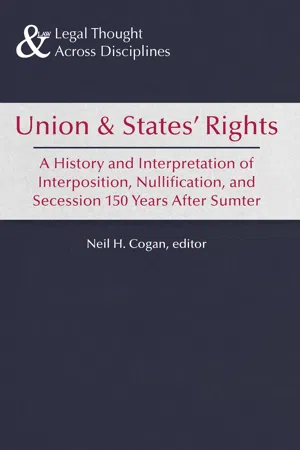History
Dred Scott Decision
The Dred Scott Decision was a landmark ruling by the U.S. Supreme Court in 1857 that declared African Americans, whether enslaved or free, were not considered citizens and therefore could not sue in federal court. The decision also invalidated the Missouri Compromise of 1820, exacerbating tensions between the North and South over the issue of slavery and contributing to the lead-up to the American Civil War.
Written by Perlego with AI-assistance
Related key terms
Related key terms
1 of 4
Related key terms
1 of 3
10 Key excerpts on "Dred Scott Decision"
- eBook - ePub
- Ian D. Loveland(Author)
- 2018(Publication Date)
- Routledge(Publisher)
[3] THE Dred Scott Decision, IN THE LIGHT OF CONTEMPORARY LEGAL DOCTRINES 1 Having had occasion recently to renew my acquaintance with the case of Scott v. Sandford, 2 I have become persuaded that the usual historical verdict with reference to it needs revision in three important particulars : first, as to the legal value of the pronouncement in that case of unconstitutionality with reference to the Missouri Compromise ; secondly, as to the basis of that pronouncement ; thirdly, as to the nature of the issue between Chief Justice Taney and Justice Curtis upon the question of citizenship that was raised by Dred Scott’s attempt to sue in the federal courts. 3 The main facts leading up to and attending this famous litigation may be summarized as follows : 4 Dred Scott, a slave belonging to an army officer named Emerson, was taken by his master from the home state, Missouri, first into the free state of Illinois and thence into that portion of the national territory from which, by the eighth section of the Missouri Compromise, slavery was “forever” excluded. Here master and slave remained two years before returning to Missouri, the latter in the meantime having married with his master’s consent. In 1852 Dred sued his master for freedom in one of the lower state courts and won the action, but upon appeal the decision was reversed by the supreme court of the state, upon the ground that Dred’s status at home was fixed by state law regardless of what it was abroad—a decision which plainly ran counter to the whole trend of decision by the same court for the previous generation. Thereupon the case was remanded to the inferior court for retrial but Dred, having in the meantime upon the death of Emerson passed by bequest to Sandford, a citizen of New York, now decided to bring a totally new action in the United States circuit court for the Missouri district, under section 11 of the Act of 1789 - eBook - ePub
American Eloquence, Volume 3
Studies In American Political History (1897)
- (Author)
- 2005(Publication Date)
- Perlego(Publisher)
"The courts are the tribunals prescribed by the Constitution and created by the authority of the people to determine, expound, and enforce the law. Hence, whoever resists the final decision of the highest judicial tribunal aims a deadly blow at our whole republican system of government—a blow which, if successful, would place all our rights and liberties at the mercy of passion, anarchy, and violence. I repeat, therefore, that if resistance to the decisions of the Supreme Court of the United States, in a matter like the points decided in the Dred Scott case, clearly within their jurisdiction as defined by the Constitution, shall be forced upon the country as a political issue, it will become a distinct and naked issue between the friends and enemies of the Constitution—the friends and the enemies of the supremacy of the laws."I have said, in substance, that the Dred Scott Decision was in part based on assumed historical facts which were not really true, and I ought not to leave the subject without giving some reasons for saying this; I therefore give an instance or two, which I think fully sustain me. Chief-Justice Taney, in delivering the opinion of the majority of the court, insists at great length that the negroes were no part of the people who made, or for whom was made, the Declaration of Independence, or the Constitution of the United States.On the contrary, Judge Curtis, in his dissenting opinion, shows that in five of the then thirteen States—to wit, New Hampshire, Massachusetts, New York, New Jersey, and North Carolina—free negroes were voters, and in proportion to their numbers had the same part in making the Constitution that the white people had. He shows this with so much particularity as to leave no doubt of its truth; and as a sort of conclusion on that point, holds the following language:"The Constitution was ordained and established by the people of the United States, through the action in each State, of those persons who were qualified by its laws to act thereon in behalf of themselves and all other citizens of the State. In some of the States, as we have seen, colored persons were among those qualified by law to act on the subject. These colored persons were not only included in the body of 'the people of the United States' by whom the Constitution was ordained and established; but in at least five of the States they had the power to act, and doubtless, did act, by their suffrages, upon the question of its adoption." - eBook - ePub
LINCOLN – Complete 7 Volume Edition: Biographies, Speeches and Debates, Civil War Telegrams, Letters, Presidential Orders & Proclamations
Including the Introduction by Theodore Roosevelt & 3 Biographies: The Every-day Life of the President, Lincoln by Carl Shurz and Abraham Lincoln by Joseph H. Choate
- Abraham Lincoln, Theodore Roosevelt, Carl Schurz, Joseph Choate, Francis F. Browne(Authors)
- 2017(Publication Date)
- Madison & Adams Press(Publisher)
The first two things they have already decided, except that there is a little quibble among lawyers between the words "dicta" and "decision." They have already decided a negro cannot be made free by Territorial legislation. What is the Dred Scott Decision? Judge Douglas labors to show that it is one thing, while I think it is altogether different. It is a long opinion, but it is all embodied in this short statement: "The Constitution of the United States forbids Congress to deprive a man of his property, without due process of law; the right of property in slaves is distinctly and expressly affirmed in that Constitution: therefore, if Congress shall undertake to say that a man's slave is no longer his slave when he crosses a certain line into a Territory, that is depriving him of his property without due process of law, and is unconstitutional." There is the whole Dred Scott Decision. They add that if Congress cannot do so itself, Congress cannot confer any power to do so; and hence any effort by the Territorial Legislature to do either of these things is absolutely decided against. It is a foregone conclusion by that court. Now, as to this indirect mode by "unfriendly legislation," all lawyers here will readily understand that such a proposition cannot be tolerated for a moment, because a legislature cannot indirectly do that which it cannot accomplish directly - eBook - ePub
- Robert P. George, Robert P. George, Robert George(Authors)
- 2016(Publication Date)
- Princeton University Press(Publisher)
CHAPTER THREEDred Scott v. Sandford and Its LegacyCASS R. SUNSTEIN[O]pinions were so various and at first so crude that it was necessary they should be long debated before any uniform system of opinion could be formed. Meantime the minds of the members were changing, and much was to be gained by a yielding and accommodating spirit.… [N]o man felt himself obliged to retain his opinion any longer than he was satisfied of their propriety and truth, and was open to the force of argument.(James Madison)The spirit of liberty [is that spirit which] is not too sure that it is right.(Learned Hand)MY TOPICS IN this chapter are the myths that the Dred Scott case created, the myths that Americans have created about it, and the true lessons of the case for three of the great constitutional issues of the current era: affirmative action, homosexuality, and the right to die.THE CONTINUING RELEVANCE OF DRED SCOTTThe Dred Scott case was probably the most important case in the history of the Supreme Court of the United States. Indeed, it was probably the most important constitutional case in the history of any nation and any court. But most of us have little if any sense of what it means or was even about. Even within the legal culture, the case is taught infrequently in constitutional law courses; outside of the legal culture, the case is pretty well forgotten, or at most a footnote in discussions of the Civil War.We should note right at the outset some of the many remarkable facts about the case.• Dred Scott was the first Supreme Court case since Marbury v. Madison invalidating a federal law. Since Marbury created judicial review in the context of a denial of jurisdiction, Dred Scott might plausibly be said to be the first real exercise of the power of judicial review.• Dred Scott was - eBook - ePub
American History through Its Greatest Speeches
A Documentary History of the United States [3 volumes]
- Jolyon P. Girard, Darryl Mace, Courtney Michelle Smith, Jolyon P. Girard, Darryl Mace, Courtney Michelle Smith, Jolyon P. Girard, Darryl Mace, Courtney Michelle Smith(Authors)
- 2016(Publication Date)
- ABC-CLIO(Publisher)
Moreover, the plaintiff, it appears, brought a similar action against the defendant in the State court of Missouri, claiming the freedom of himself and his family upon the same grounds and the same evidence upon which he relies in the case before the court. The case was carried before the Supreme Court of the State, was fully argued there, and that court decided that neither the plaintiff nor his family were entitled to freedom, and were still the slaves of the defendant, and reversed the judgment of the inferior State court, which had given a different decision. If the plaintiff supposed that this judgment of the Supreme Court of the State was erroneous, and that this court had jurisdiction to revise and reverse it, the only mode by which he could legally bring it before this court was by writ of error directed to the Supreme Court of the State, requiring it to transmit the record to this court. If this had been done, it is too plain for argument that the writ must have been dismissed for want of jurisdiction in this court. The case of Strader and others v. Graham is directly in point, and, indeed, independent of any decision, the language of the 25th section of the act of 1789 is too clear and precise to admit of controversy. . . . Upon the whole, therefore, it is the judgment of this court that it appears by the record before us that the plaintiff in error is not a citizen of Missouri in the sense in which that word is used in the Constitution, and that the Circuit Court of the United States, for that reason, had no jurisdiction in the case, and could give no judgment in it. Its judgment for the defendant must, consequently, be reversed, and a mandate issued directing the suit to be dismissed for want of jurisdiction.Source: Dred Scott v. Sandford, 60 U.S. 393 (1857).3. Frederick Douglass, “Speech on the Dred Scott Case” (1857)
In this speech, delivered in May 1857, Frederick Douglass, the most prominent black abolitionist of his day, draws upon the Bible, the United States Constitution, the Declaration of Independence, and Enlightenment thinking to decry the U.S. Supreme Court decision in Dred Scott v. Sandford. In the majority opinion of this Supreme Court ruling, Chief Justice Roger Taney argued that the complainant Dred Scott was still a slave even though he had lived a significant portion of his life as a slave in territories that did not sanction slavery. However, Chief Justice Taney did not stop there; rather, he added, the Missouri Compromise of 1820, and any legislation that restricted the spread of slavery, were unconstitutional. Moreover, Taney argued that whites did not have to respect the rights of blacks.Frederick Douglass attacked Chief Justice Taney’s decision by noting that the abolitionist cause had endured in the face of all opposition. The Dred Scott ruling, for Douglass, was simply another obstacle to overcome. He was, however, confident in his cause. Douglass pointed to the Declaration of Independence, and the claims of natural rights contained within, as proof that America would eventually overthrow the institution of slavery. He proclaimed that God’s law superseded any law or any ruling laid out by man. - eBook - ePub
Fanatics and Fire-eaters
Newspapers and the Coming of the Civil War
- Lorman A. Ratner, Dwight L. Teeter Jr.(Authors)
- 2010(Publication Date)
- University of Illinois Press(Publisher)
3 The Dred Scott Decision and a Society of Laws In the summer months of 1856, with the Brooks-Sumner incident no longer hot news, the press turned its attention back to Kansas. While pro- and antislavery supporters continued to pour verbal abuse on one another, particularly through the newspapers, a new round of violence broke out. The violence was centered along the Wakarusa River near the town of Lawrence. There, the preceding spring, a proslavery force had attacked the predominantly antislavery community, burning, looting, and killing some of its residents. The new confrontation saw some fifteen hundred supporters of slavery gather in the area. Before a major conflict could occur, the territorial governor managed to calm the situation. But anyone who read a newspaper was aware of “Bleeding Kansas.” It was in that charged atmosphere that the justices of the Supreme Court of the United States were deliberating a long-standing dispute that, although not set in Kansas, would have important implications for tensions there and in any place in the country where the question of the right of one person to hold another in bondage might be raised. By late winter of 1857 the Court rendered a decision in the case of Dred Scott v. Sanford. On March 4, 1857, Chief Justice of the Supreme Court Roger Taney administered the presidential oath of office to James Buchanan, a Democrat from Pennsylvania. Two days later, the eighty-one-year-old chief justice, speaking in a voice so weak it was barely audible, announced the decision of the Court’s majority in a case that had been working its way through local, state, and federal courts for a decade and had been heard for a second time by the highest court. 1 The case involved a suit brought by a slave named Dred Scott against his owner - Abraham Lincoln, Daniel Kilham Dodge, (Authors)
- 2004(Publication Date)
- Perlego(Publisher)
The negro's name was "Dred Scott," which name now designates the decision finally made in the case. Before the then next presidential election, the law case came to and was argued in the Supreme Court of the United States; but the decision of it was deferred until after the election. Still, before the election, Senator Trumbull, on the floor of the Senate, requested the leading advocate of the Nebraska bill to state his opinion whether the people of a Territory can constitutionally exclude slavery from their limits; and the latter answers: "That is a question for the Supreme Court." The election came. Mr. Buchanan was elected, and the indorsement, such as it was, secured. That was the second point gained. The indorsement, however, fell short of a clear popular majority by nearly four hundred thousand votes, and so, perhaps, was not overwhelmingly reliable and satisfactory. The out-going President, in his last annual message, as impressively as possible echoed back upon the people the weight and authority of the indorsement. The Supreme Court met again; did not announce their decision, but ordered a reargument. The presidential inauguration came, and still no decision of the court; but the incoming President in his inaugural address fervently exhorted the people to abide by the forthcoming decision, whatever it might be. Then, in a few days, came the decision. The reputed author of the Nebraska bill finds an early occasion to make a speech at this capital indorseing the Dred Scott Decision, and vehemently denouncing all opposition to it- eBook - ePub
Remaking the Republic
Black Politics and the Creation of American Citizenship
- Christopher James Bonner(Author)
- 2020(Publication Date)
- University of Pennsylvania Press(Publisher)
CHAPTER 5Contesting the “Foul and Infamous Lie” of Dred ScottIn the antebellum decades, African Americans worked through the vagueness of citizenship to claim legal protections and make arguments about the relationships between individuals and governments. Their work helped push northern lawmakers to pass personal liberty laws. Even in areas where they did not make tangible gains, activists forced lawmakers to think about the content of citizenship and black people’s legal status. Federal lawmakers tried to curtail certain forms of black politics with the Fugitive Slave Act of 1850, but citizenship remained undefined and continued to be useful for black activists. In 1857, Supreme Court Chief Justice Roger Taney looked to foreclose the opportunity of citizenship when he dismissed Dred Scott’s freedom suit on the grounds that no black person had been or could be a citizen of the United States. The Dred Scott decision threatened black people’s work to use citizenship in pursuit of rights. On response, activists adopted new tactics designed to ensure the status remained unsettled and useful for their politics.The chief questions in Dred Scott’s suit concerned slavery in the territories and the processes of emancipation, but much of Taney’s decision focused on explaining why black people could not be citizens in order to exclude them from American political, legal, or social communities.1 The chief justice worried that freedom suits in federal court might destabilize slavery, but he was also concerned about the implications of black citizenship politics. Taney’s decision reflected his awareness of black protest strategies and his desire to prevent activists from using citizenship to seek legal protections.After Dred Scott, activists continued to pursue specific legal protections, but Taney’s decision permeated black political life. On September 14, 1858, for example, thirty-seven black men gathered for a state convention in Troy, New York, to demand the repeal of the state’s property qualification for black voters, which had stood since 1821.2 In addition to seeking changes in state laws, they spoke out against Chief Justice Taney’s opinion. Taney handed down his ruling eighteen months before the Troy convention, but activists refused to leave it in the past. And so William J. Watkins stood before his colleagues at the concert hall in Troy and denied that Roger Taney had the authority to interpret the U.S. Constitution. Watkins was the son of a Maryland activist also named William Watkins. He worked as a teacher in Rochester while also traveling to give abolitionist lectures and collaborating with Frederick Douglass on his publishing work.3 The younger Watkins did not mince words when he spoke about Taney’s ruling. “The Dred Scott decision is a foul and infamous lie,” he declared, “which neither black men nor white men are bound to respect.” The ruling perverted fundamental constitutional principles; it was simply untrue that black people were not citizens. Rather than a statement of legal fact, Watkins called the decision “an utterance of individual political opinions” and urged people to reject the ruling in order to defend the republic.4 - eBook - ePub
The Limits of Judicial Power
The Supreme Court in American Politics
- William Lasser(Author)
- 2017(Publication Date)
- The University of North Carolina Press(Publisher)
104 He deliberately left unclear what he meant by the phrase “when fully settled,” though it was certain that the Court’s decision did not end the matter.Lincoln was also ambiguous in his debates with Douglas, preferring to put his opponent on the defensive rather than clarify his own position. Early in the summer of 1858, however, he had sketched out his views on the binding authority of Supreme Court decisions. Lincoln contended that a Court decision resolves the immediate question before the Court, and also indicates “that when a question comes up upon another person it will be so decided again, unless the court decides in another way”; unless, that is, “the court overrules its decision.”105 Then, citing Andrew Jackson’s veto of the Bank of the United States recharter, Lincoln argued that “the Supreme Court had no right to lay down a rule to govern a coordinate branch of the government.”106 Therefore, he concluded, Republicans “do not propose to be bound by” the Dred Scott decision “as a political rule.”107 The Court’s decision clearly had to be accepted as regards Dred Scott himself, but Republicans could nevertheless work for a reversal.Lincoln’s position was full of holes, the largest of which was his absurdly narrow view of precedent. He struggled with this problem as late as his 1861 inaugural address, trying to reconcile his condemnation of the Dred Scott decision with his respect for judicial power. He concluded that if the policy of the nation on vital questions is to be “irrevocably fixed by the decisions of the Supreme Court, the instant they are made,” then “the people will have ceased, to be their own rulers, having … practically resigned their government, into the hands of that eminent tribunal.” In the next sentence, however, Lincoln showed the essential Republican ambiguity toward the Court: “Nor is there, in this view, any assault upon the court, or the judges.”108 - eBook - ePub
Union and States' Rights
A History and Interpretation of Interposition, Nullification, and Secession 150 Years After Sumter
- Neil H. Cogan(Author)
- 2012(Publication Date)
- University of Akron Press(Publisher)
Sandford, 91 the most notoriously proslavery decision in the nation’s jurisprudence. The outcome of the case—that Scott remained a slave—was plausibly correct on the basis of Strader v. Graham, if nothing else. 92 Scott claimed his freedom because he had lived in the free state of Illinois and in the Wisconsin Territory, where slavery was banned by the Compromise of 1820 and various other federal laws. 93 The Court initially planned to decide the case on the basis of Strader, and had it done so, the case would probably be long forgotten. But the Southerners on the Court insisted on a more comprehensive result, which led to Taney’s massive and extraordinarily proslavery opinion. 94 Writing for the Court, Taney held that (1) slavery was a specially protected property under the Constitution; (2) free blacks could never be considered citizens of the United States and essentially had “no rights” under the Constitution; (3) that Congress had no power to ban slavery in the federal territories; (4) no law in the territories could free slaves because that would be an unconstitutional taking under the 5th Amendment; and (5) the Missouri Compromise unconstitutionally banned slavery in the federal territories, and by implication the ban on slavery in the Act creating the Oregon Territory was also unconstitutional. This sweeping opinion settled the issue by allowing slavery in all existing federal territories. A concurring opinion by Justice Samuel Nelson of New York also directly telegraphed how the Court would rule on the issue of slave transit. Nelson noted at the very end of his opinion: A question has been alluded to, on the argument, namely: the right of the master with his slave of transit into or through a free State, on Business or commercial pursuits, or in the exercise of a Federal right, or the discharge of a Federal duty, being a citizen of the United States, which is not before us
Index pages curate the most relevant extracts from our library of academic textbooks. They’ve been created using an in-house natural language model (NLM), each adding context and meaning to key research topics.
Explore more topic indexes
Explore more topic indexes
1 of 6
Explore more topic indexes
1 of 4
